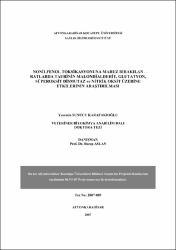Nonilfenol Toksikasyonuna Maruz Bırakılan Ratlarda Taurinin Malondialdehit, Glutatyon, Süperoksit Dismutaz ve Nitrik Oksit Üzerine Etkilerinin Araştırılması
Özet
Günümüz yaşamı toksik etkili pek çok çevresel kimyasal maddenin tehditi altındadır. Bu
maddelerden biri de endüstride yaygın olarak kullanılan, yüzey gerilimini azaltıcı etkili
nonilfenol (NF)’dir. Toksik faktörlere karşı korunmada antioksidanların rolünün anlaşılması
ile birlikte hangi antioksidanın hangi dozda ve hangi olgularda daha etkili olduğunun
saptanması önemli hale gelmiştir. Bu çalışma ile güçlü bir antioksidan olan taurinin
nonilfenole bağlı oksidatif stresten korunmadaki rolünün kan örneklerinde araştırılması
amaçlanmıştır. Çalışmada, ağırlıkları 175-250 g arasında değişen 3-4 aylık 40 adet erkek
“Wistar-albino” rat kullanılmıştır. Deney grupları her birinde 8 hayvan bulunacak şekilde,
Kontrol Grubu, Taurin Grubu, Nonilfenol Grubu, Nonilfenol+Taurin Grubu ve NF’nin alkol
içerisinde çözülerek uygulanmasından oluşan Alkol Grubu (A) olmak üzere 5 gruba
ayrılmıştır. Deneme için 1 μl’sinde 1μg nonilfenol içeren nonilfenol stok solüsyonu, alkol
içinde hazırlanmış, 50 μg/kg nonilfenol içeren bu çözelti NF ve NFT Gruplarında ratların
diyetlerine püskürtme tarzında ilave edilmiştir. Alkol Grubunun diyetlerine ise sadece 50 μl
alkol püskürtme tarzında ilave edilmiştir. Ayrıca T ve NFT Grubu içme sularına % 3 (v/w)
oranında taurin ilave edilmiştir. Lipit peroksidasyonu göstergelerinden MDA’nın, tüm deney
gruplarında Kontrol Grubuna oranla anlamlı olarak arttığı (P<0.05) ancak sadece taurin
uygulanan ve NF ile birlikte taurin verilen hayvanlardaki MDA düzeylerinin, yalnızca NF ve
yine tek başına alkol verilen hayvanlardaki MDA seviyesinden, istatiksel olarak düşük olduğu
dikkat çekmektedir (P<0.05). GSH sonuçları; NF, NFT ve A Gruplarındaki GSH düzeyinin,
Kontrol Grubuna göre anlamlı olarak azalmış olduğunu (P<0.001), T Grubunda ise Kontrol
Grubu düzeylerinin üzerine çıktığını (P<0.001) göstermektedir. SOD düzeylerine ait sonuçlar
karşılaştırıldığında, NF, NFT ve A Gruplarında SOD düzeyinin, Kontrol Grubuna göre
anlamlı olarak azalmış olduğu (P<0.01), sadece taurin verilen grupta ise, SOD düzeyinin
anlamlı olarak arttığı (P<0.01) görülmektedir. NOx seviyeleri, nonilfenol verilen ratlarda
azalmıştır (P<0.01). NF yanı sıra taurin verilen NFT Grubunun, sadece alkol ve yine yalnızca taurin verilen gruplardaki NOx miktarlarının, Kontrol Grubundan yüksek olduğu dikkat
çekmiştir (P<0.01).
Sonuç olarak, nonilfenol gibi endüstriyel kimyasallar tarafından indüklenebilecek oksidatif
stresi önlemede antioksidan savunma duvarını güçlendirmek için taurin gibi antioksidanların
verilmesinin önemli olduğu; diğer yandan verilen antioksidan maddenin en etkin dozunun
belirlenebilmesi için ise başka çalışmalara gereksinim duyulduğu görülmüştür. Today’s life is under threat of various toxic-influential environmental and chemical substances.
Nonylphenol (NP), surface tension reductive chemical, is considered to be one of those substances and
is widely used in the industry. As a consequence of understanding antioxidants’ role in preventing
against toxic factors, it has become quite significant to determine which antioxidant is effectual and
safely at what dose on which events. Investigating the role of taurine, a powerful antioxidant, in
preventing nonylphenol bound oxidative stress in the blood samples was aimed in this study. 40
“Wistar-albino” male rats weighed between 175 and 250 g and aged between 3 and 4 months were
used in the study. Experimental rats were equally distrubuted amongst five groups provided that each
has 8 of them: Control Group, Taurine Group, Nonylphenol Group, Nonylphenol + Taurine Group,
and Alcohol Group since nonylphenol was treated and dissolved in the alcohol. As for piloting,
nonylphenol stock solution including 1 μg nonylphenol in 1μl was prepared in the alcohol and the
solution which has 50 μg/kg nonylphenol was added through spraying into the diets of the rats placed
in the Nonylphenol and Nonylphenol+Taurine Groups. Only 50 μl alcohol was added through
spraying into the diets of the Alcohol Group. Besides, taurin at the rate of 3 % (v/w) was added to the
drinking water of the Taurine and Nonylphenol+Taurine Group. MDA as a marker of lipit
peroxidation appeared to increase (P<0.05) in all the experiment groups in proportion to the controls.
However, the MDA levels in the rats treated only with taurine and treated with taurine in addition to
nonylphenol appeared to be lower statistically than the MDA levels in the rats treated only with
nonylphenol and treated merely with alcohol (P<0.05). GSH results indicated that GSH levels in the
Nonylphenol, Nonylphenol+Taurine and Alcohol Groups decreased meaningfully (P<0.001) compared
with that of the Control Group. Whereas, GSH levels in the Taurine Group appeared to be higher than
that of the controls (P<0.001). When the results for the SOD levels are taken into consideration, the
SOD level for the Nonylphenol, Nonylphenol+Taurine and Alcohol Groups appeared to decrease
meaningfully in comparison to that of the Control Group (P<0.01). Nevertheless, the SOD level
seemed to rise meaningfully in the group treated merely with taurine (P<0.01). The NOx levels were reduced amongst the rats treated with nonylphenol (P<0.01). The NOx levels within the groups treated
only with alcohol and taurine and in the Nonylphenol Group along with taurine given
Nonylphenol+Taurine Group appeared to be higher than that of the Control Group (P<0.01).
As for conclusion, it has become apparent to apply antioxidants such as taurine in order to strengthen
the antioxidant defense wall while preventing oxidative stress induced by industrial chemicals such as
nonylphenol. Moreover, it became clear that further studies to be conducted in this area in order to
determine the most influential antioxidant substance and its safely doses.
Bağlantı
http://hdl.handle.net/11630/3997Koleksiyonlar
- Doktora Tezleri [154]



















